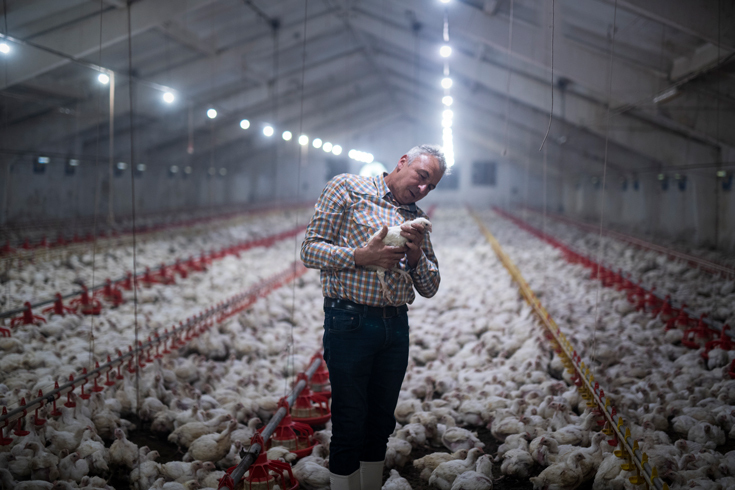In 1997, Lam Hoi-Ka, a previously healthy three-year-old boy, died of multiple organ failure in Hong Kong. When a team of virologists from the Netherlands declared that the death-dealing agent had been H5N1, a virus that was previously known to infect only birds, scientists were shocked. The theoretical possibility of a deadly global pandemic, similar to the 1918 flu that killed millions of people, was suddenly made real.
While scientists from around the world urgently tracked down the origins and initial spread of the new virus, the rest of us watched the television images of people in hazmat suits. What made these images confusing and alarming were the stories that accompanied them. In Hong Kong, a chicken-adapted virus had jumped directly to a person. For most people, chickens were “healthy, low-fat” meat you bought in plastic packages at the grocery store, not agents of mass death.
As a veterinarian and epidemiologist, I knew better. A decade before the H5N1 virus struck, I stood in a southern Ontario broiler barn—that is, a barn where chickens are grown for meat. In my plastic boots, white throwaway safety suit, and face mask, I gazed out over 10,000 identical birds. The room was spacious and the litter was clean. Delivery of food, water, and air was computer controlled. The birds were white feathered, plump, and only mildly curious about life. These were urban, office-dwelling birds. In five weeks, they could grow to the exact size required by KFC.
By the wonders of genetics and intensive breeding for specific traits, the fiercely wild stock of jungle fowl had been transformed into something that could grow faster, more uniformly, and by some standards, more efficiently. Between 1961 and 2017, world poultry meat production increased from 9 million to 122 million tons and egg production shot up from 15 million to 87 million tons. Since most of us experience a sort of cognitive dissonance when we see chickens and tons in the same sentence, let me rephrase this. In 1961, there were just over 3 billion people and just under 4 billion chickens in the world. In 2020, as I write this, about 7.7 billion people are jostling and shouting for space here, along with more than 20 billion chickens—and perhaps as many as 50 billion if one considers the short slaughter-and-restock turnover of those populations.
The fastest growth in commercial poultry production has been in the developing world. By the late 1990s, countries such as Indonesia and Brazil were increasing their commercial production by about 10 percent a year. When I was visiting South Sudan in 2012, just a few months after it gained independence following thirty years of civil war, I found “fresh” Brazilian chicken for sale in the market in Juba, the capital. China, already one of the world’s biggest producers, was increasing at about 4 percent annually in the 1990s. Chickens were being grown, trucked, shipped, and fried as fast as the technology allowed. Who would have thought that so many people on this planet could be fed with such apparent ease?
The geneticists helped. These birds feeding the world weren’t just any old chickens. In 2018, the authors of a peer-reviewed research paper declared that the “skeletal morphology, pathology, bone geochemistry and genetics” of modern commercial chickens—whose global body mass now exceeds that of all other birds combined—are so different from their ancestors that they may be considered a “novel morphotype.”
But, in ecology—which is to say, in a world where everything is, sooner or later, connected to everything else—there are costs and trade-offs. According to that same paper, these new chickens symbolized “the unprecedented human reconfiguration of the Earth’s biosphere”—a feat that would create the perfect conditions for barn-size outbreaks and then fit so neatly into a globally integrated system that would create the perfect conditions for pandemics. By the end of the twentieth century, epidemiologists who specialized in food-borne diseases were already well aware that a pandemic of salmonellosis, a disease with both immediate effects on the gastrointestinal system and long-term effects on arthritis and cardiovascular disease, was one of the hidden costs of mass producing chicken.
Salmonellosis could have been taken as a warning from the chickens of the world, a shot across the bow, as it were. The omen was not cryptic. It might have been something like: chickens carry their own bacterial and viral microbiomes; the economies of scale for chicken production are the same as the economies of scale for disease; small farms have outbreaks; big farms breed epidemics; globalization of big farms creates pandemics.
Southeast Asian farmers didn’t scale up their production and increase the volume and speed of their trade in poultry products just “because”; they were responding to market demands for low-cost animal food. According to the United Nations, one in three people lived in a city in 1960. By the end of the twentieth century, almost half of all people did; by 2030, more than 60 percent of the population is expected to live in cities. Urban people want to eat, and most often, they want animal protein. Yet, without that rapid economic growth and urbanization, avian influenza would likely have remained a minor problem.
Brazil, the United States, China, and the European Union are the world’s biggest poultry producers. China leads the world in ducks and geese. Other countries in Southeast Asia—Thailand in particular—wanted to take advantage of these expanding urban markets and jumped into the hot economic fray. In places such as Thailand and Indonesia, increased production has sometimes been achieved by taking traditional, laid-back, no-input chicken rearing and scaling it up. However, when waterfowl are mixed with chickens and pigs and people in close quarters—as can often happen in Southeast Asia—novel opportunities for the viruses are created, they become genetically more unstable, and evolution is accelerated.
In 1996, a precursor of the H5N1 virus killed some geese in southern China. No one paid much attention. Then the virus picked up some gene fragments from quail and ducks, spread to the poultry markets in Hong Kong, and made the leap to humans; it killed six of eighteen people who were infected. Mass killing of all the domestic poultry in Hong Kong temporarily stopped the problem, but the virus continued to infect ducks and geese and to happily, sloppily evolve. In late 2002, a new variation of the virus killed off most of the waterfowl in Hong Kong nature parks. In the next few years, the new, more lethal variant spread through Vietnam, Thailand, Indonesia, Cambodia, Laos, China, Malaysia—the whole regional market. Not only was it making birds sick and killing them but it was also infecting cats and ferrets and, finally, people.
In May and June of 2005, one of the new variants of H5N1 killed more than 5,000 wild bar-headed geese, gulls, and ducks in Qinghai Lake, China. Many researchers were worried that migratory birds would carry the virus down flyways into India. It looks as if they may have indeed carried the virus to Europe and Africa, but the evidence will always be ambiguous. However, it would be disingenuous to suggest that intensification and global genetic “homogenization” of poultry production have not been driving forces in a variety of epidemics, including H5N1.
Knowledge of the social and ecological dimensions of food should be part of every food consumer’s education. An inability to talk intelligently about where that food comes from should be grounds for dismissal of politicians and corporate heads.
Some pontificators, for example, have suggested that farmers in south and east Asia should raise chickens the way we do in North America and Europe—inside tightly controlled buildings. These people have never lived in poor countries in the humid tropics, nor do they understand the systemic ramifications of creating a few large farms where once there were many small ones. If they want biosecurity such as we have in Europe and North America, tropical farmers would need to close off the barns. But, in the tropics, without air conditioning, the birds would start to die within minutes. With what power source would they air-condition? And what would happen to all those poor farmers in the countryside who depend on small flocks of poultry for food and to pay their school and medical bills? Even if we kill all the sick chickens and put the rest into air-conditioned hotels, there will still be ducks flying overhead or cats or ferrets slinking in and out of the shrubbery. Some of the largest outbreaks of avian influenza have been in some of the best-managed poultry operations in the world, in some of the wealthiest countries. The viruses, like all microbes, adapt quickly to new situations.
In the years following the initial outbreaks of avian influenza, I spent a lot of time and energy working with policy makers in Canada, looking at how to prevent the disease from entering North America, and with farmers in Southeast Asia, looking for ways to stop the epidemic at the source. Many officials and corporate leaders were encouraging countries to follow a program of test-and-slaughter and of discouraging villagers from raising free-run village chickens. In March 2008, at a market in eastern Thailand, I discovered that, if sellers were responding to economic incentives, the programs designed to stop people from raising backyard chickens were unlikely to succeed. According to a woman with a dozen gutted and cleaned birds in front of her, village chicken was going for about twice as much on a per-weight basis as the commercially reared broilers.
The next month, at the invitation of my Indonesian coworkers, my wife and I visited a Javanese village in an area reported to be highly endemic for avian influenza. Of course, villagers who attended our workshop claimed to have had no confirmed cases of bird flu. Of course, any birds that died had succumbed to some other disease.
After the meeting, the villagers took us to see their chickens. Their greatest source of pride were their Ayam Pelung—competitive singing roosters. They were tall—about a metre high—and their calls were long, drawn out, low voiced, reminding me of Cesária Évora, the “barefoot diva” of Cape Verde. These singing roosters were each worth $2,000 to $3,000 (US), which was more than the annual income of most of these farmers. One of the farmers was a breeder who had sold roosters to buyers from as far away as Japan. A program that relied on slaughtering chickens that tested positive and paying compensation at market rates for commercial broilers was a nonstarter for these villagers.
I remembered, then, seeing a competition of Javanese singing roosters back in 1986. The birds were in cages, high up on swaying poles, judges moving from bird to bird, listening. Were they listening for omens? Warnings of a pandemic night just over the horizon?
I do not know what criteria the judges used, but standing there in the cool of a shady tropical morning, hearing those fado-like songs of love and loss, I yearned to believe, as the Zoroastrians did, that the calls of those jungle fowl might drive away the devils of the night.
From the book On Pandemics: Deadly Diseases from the Bubonic Plague to Coronavirus, by David Waltner-Toews, available now from Greystone Books. Excerpted and adapted with permission of the publisher.





